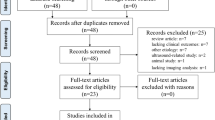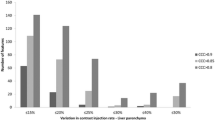Abstract
Purpose
To test the technical reproducibility of acquisition and scanners of CT image-based radiomics model for early recurrent hepatocellular carcinoma (HCC).
Methods
We included primary HCC patient undergone curative therapies, using early recurrence as endpoint. Four datasets were constructed: 109 images from hospital #1 for training (set 1: 1-mm image slice thickness), 47 images from hospital #1 for internal validation (sets 2 and 3: 1-mm and 10-mm image slice thicknesses, respectively), and 47 images from hospital #2 for external validation (set 4: vastly different from training dataset). A radiomics model was constructed. Radiomics technical reproducibility was measured by overfitting and calibration deviation in external validation dataset. The influence of slice thickness on reproducibility was evaluated in two internal validation datasets.
Results
Compared with set 1, the model in set 2 indicated favorable prediction efficiency (the area under the curve 0.79 vs. 0.80, P = 0.47) and good calibration (unreliability statistic U: P = 0.33). However, in set 4, significant overfitting (0.63 vs. 0.80, P < 0.01) and calibration deviation (U: P < 0.01) were observed. Similar poor performance was also observed in set 3 (0.56 vs. 0.80, P = 0.02; U: P < 0.01).
Conclusions
CT-based radiomics has poor reproducibility between centers. Image heterogeneity, such as slice thickness, can be a significant influencing factor.



Similar content being viewed by others
Data availability
Previously reported picture and model construction data were used to support this study and are available at https://doi.org/10.1186/s40644-019-0197-5. The prior study is cited at relevant places within the text as Ref. [26].
References
Lambin P, Rios-Velazquez E, Leijenaar R et al (2012) Radiomics: extracting more information from medical images using advanced feature analysis. Eur J Cancer (Oxford, England: 1990) 48(4):441–446
Gillies RJ, Kinahan PE, Hricak H (2016) Radiomics: images are more than pictures, they are data. Radiology 278(2):563–577
Neri E, Del Re M, Paiar F et al (2018) Radiomics and liquid biopsy in oncology: the holons of systems medicine. Insights Imaging 9(6):915–924
Lambin P, Leijenaar RTH, Deist TM et al (2017) Radiomics: the bridge between medical imaging and personalized medicine. Nat Rev Clin Oncol 14(12):749–762
Cozzi L, Dinapoli N, Fogliata A et al (2017) Radiomics based analysis to predict local control and survival in hepatocellular carcinoma patients treated with volumetric modulated arc therapy. BMC Cancer 17(1):829
Zhou Y, He L, Huang Y et al (2017) CT-based radiomics signature: a potential biomarker for preoperative prediction of early recurrence in hepatocellular carcinoma. Abdom Radiol (NY) 42:1695–1704
Coroller TP, Grossmann P, Hou Y et al (2015) CT-based radiomic signature predicts distant metastasis in lung adenocarcinoma. Radiother Oncol J Eur Soc Ther Radiol Oncol 114(3):345–350
Parmar C, Leijenaar RT, Grossmann P et al (2015) Radiomic feature clusters and prognostic signatures specific for Lung and Head & Neck cancer. Sci Rep 5:11044
Fried DV, Tucker SL, Zhou S et al (2014) Prognostic value and reproducibility of pretreatment CT texture features in stage III non-small cell lung cancer. Int J Radiat Oncol Biol Phys 90(4):834–842
Braman NM, Etesami M, Prasanna P et al (2017) Intratumoral and peritumoral radiomics for the pretreatment prediction of pathological complete response to neoadjuvant chemotherapy based on breast DCE-MRI. Breast Cancer Res BCR 19(1):57
Leijenaar RT, Carvalho S, Hoebers FJ et al (2015) External validation of a prognostic CT-based radiomic signature in oropharyngeal squamous cell carcinoma. Acta Oncol (Stockh, Swed) 54(9):1423–1429
Chen LD, Liang JY, Wu H et al (2018) Multiparametric radiomics improve prediction of lymph node metastasis of rectal cancer compared with conventional radiomics. Life Sci 208:55–63
Chalkidou A, O’Doherty MJ, Marsden PK (2015) False discovery rates in PET and CT studies with texture features: a systematic review. PLoS ONE 10(5):e0124165
Mackin D, Fave X, Zhang L et al (2015) Measuring computed tomography scanner variability of radiomics features. Investig Radiol 50(11):757–765
Kim H, Park CM, Lee M et al (2016) Impact of reconstruction algorithms on CT radiomic features of pulmonary tumors: analysis of intra- and inter-reader variability and inter-reconstruction algorithm variability. PLoS ONE 11(10):e0164924
Shafiq-Ul-Hassan M, Zhang GG, Latifi K et al (2017) Intrinsic dependencies of CT radiomic features on voxel size and number of gray levels. Med Phys 44(3):1050–1062
Lu L, Ehmke RC, Schwartz LH, Zhao B (2016) Assessing agreement between radiomic features computed for multiple CT imaging settings. PLoS ONE 11(12):e0166550
Balagurunathan Y, Gu Y, Wang H et al (2014) Reproducibility and prognosis of quantitative features extracted from CT images. Transl Oncol 7(1):72–87
Balagurunathan Y, Kumar V, Gu Y et al (2014) Test-retest reproducibility analysis of lung CT image features. J Digit Imaging 27(6):805–823
Berenguer R, Pastor-Juan MDR, Canales-Vazquez J et al (2018) Radiomics of CT features may be nonreproducible and redundant: influence of CT acquisition parameters. Radiology 288(2):407–415
van Timmeren JE, Leijenaar RTH, van Elmpt W et al (2016) Test–retest data for radiomics feature stability analysis: generalizable or study-specific? Tomography (Ann Arbor, Mich) 2(4):361–365
Shafiq-Ul-Hassan M, Zhang GG, Hunt DC et al (2018) Accounting for reconstruction kernel-induced variability in CT radiomic features using noise power spectra. J Med Imaging (Bellingham, Wash) 5(1):011013
Ahn SJ, Kim JH, Lee SM, Park SJ, Han JK (2019) CT reconstruction algorithms affect histogram and texture analysis: evidence for liver parenchyma, focal solid liver lesions, and renal cysts. Eur Radiol 29(8):4008–4015
Solomon J, Mileto A, Nelson RC, Roy Choudhury K, Samei E (2016) Quantitative features of liver lesions, lung nodules, and renal stones at multi-detector row CT examinations: dependency on radiation dose and reconstruction algorithm. Radiology 279(1):185–194
Prasanna P, Patel J, Partovi S, Madabhushi A, Tiwari P (2017) Radiomic features from the peritumoral brain parenchyma on treatment-naive multi-parametric MR imaging predict long versus short-term survival in glioblastoma multiforme: preliminary findings. Eur Radiol 27(10):4188–4197
Shan QY, Hu HT, Feng ST et al (2019) CT-based peritumoral radiomics signatures to predict early recurrence in hepatocellular carcinoma after curative tumor resection or ablation. Cancer Imaging 19(1):11
Kudo M (2011) Adjuvant therapy after curative treatment for hepatocellular carcinoma. Oncology 81(Suppl 1):50–55
Lin S, Hoffmann K, Schemmer P (2012) Treatment of hepatocellular carcinoma: a systematic review. Liver Cancer 1(3–4):144–158
Vasquez MM, Hu C, Roe DJ, Chen Z, Halonen M, Guerra S (2016) Least absolute shrinkage and selection operator type methods for the identification of serum biomarkers of overweight and obesity: simulation and application. BMC Med Res Methodol 16(1):154
Gui J, Li H (2005) Penalized Cox regression analysis in the high-dimensional and low-sample size settings, with applications to microarray gene expression data. Bioinformatics (Oxford, England) 21(13):3001–3008
Soubrane O, Schwarz L, Cauchy F et al (2015) A conceptual technique for laparoscopic right hepatectomy based on facts and oncologic principles: the caudal approach. Ann Surg 261(6):1226–1231
Babyak MA (2004) What you see may not be what you get: a brief, nontechnical introduction to overfitting in regression-type models. Psychosom Med 66(3):411–421
Fave X, Cook M, Frederick A et al (2015) Preliminary investigation into sources of uncertainty in quantitative imaging features. Comput Med Imaging Graph 44:54–61
Kaasalainen T, Palmu K, Reijonen V, Kortesniemi M (2014) Effect of patient centering on patient dose and image noise in chest CT. AJR Am J Roentgenol 203(1):123–130
Toth T, Ge Z, Daly MP (2007) The influence of patient centering on CT dose and image noise. Med Phys 34(7):3093–3101
Habibzadeh MA, Ay MR, Asl AR, Ghadiri H, Zaidi H (2012) Impact of miscentering on patient dose and image noise in x-ray CT imaging: phantom and clinical studies. Phys Med PM Int J Devoted Appl Phys Med Biol 28(3):191–199
Li J, Udayasankar UK, Toth TL, Seamans J, Small WC, Kalra MK (2007) Automatic patient centering for MDCT: effect on radiation dose. AJR Am J Roentgenol 188(2):547–552
Matsubara K, Koshida K, Ichikawa K et al (2009) Misoperation of CT automatic tube current modulation systems with inappropriate patient centering: phantom studies. AJR Am J Roentgenol 192(4):862–865
Kaasalainen T, Palmu K, Lampinen A, Kortesniemi M (2013) Effect of vertical positioning on organ dose, image noise and contrast in pediatric chest CT—phantom study. Pediatr Radiol 43(6):673–684
Zhao B, Tan Y, Tsai WY et al (2016) Reproducibility of radiomics for deciphering tumor phenotype with imaging. Sci Rep 6:23428
Funding
This study was supported by National Natural Science Foundation of China (No. 81701701), Natural Science Foundation of Guangdong province (Nos. 2017A030313661 and 2016A030310143), and Science and Technology Planning Project of Guangdong Province of China (No. 20160904).
Author information
Authors and Affiliations
Corresponding authors
Ethics declarations
Conflict of interest
The authors declare that they have no conflict of interest.
Ethical standard
Research involves human participants. All data was from routine clinical test, and there was no clinical intervention for the participants in the study.
Informed consent
All informed consent for the routine clinical tests were obtained from participants. While for the retrospective nature of this study, informed consents for participating in this study was waived by the Institutional Review Board.
Additional information
Publisher's Note
Springer Nature remains neutral with regard to jurisdictional claims in published maps and institutional affiliations.
Electronic supplementary material
Below is the link to the electronic supplementary material.
Rights and permissions
About this article
Cite this article
Hu, Ht., Shan, Qy., Chen, Sl. et al. CT-based radiomics for preoperative prediction of early recurrent hepatocellular carcinoma: technical reproducibility of acquisition and scanners. Radiol med 125, 697–705 (2020). https://doi.org/10.1007/s11547-020-01174-2
Received:
Accepted:
Published:
Issue Date:
DOI: https://doi.org/10.1007/s11547-020-01174-2




